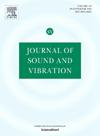侧风作用下高速磁悬浮列车-导轨耦合系统动力学与稳定性分析
IF 4.3
2区 工程技术
Q1 ACOUSTICS
引用次数: 0
摘要
沿海地区的强横风对高速磁悬浮列车的运行安全和性能构成重大风险。这些风会导致气动性能下降和不稳定性增加,进而严重影响运行安全和乘客舒适度。为应对这些挑战,本研究旨在开发一种综合气动载荷的数值模拟模型,以便深入研究高速磁悬浮列车导轨系统在横风条件下的动态响应和特性。建立了一个具有 442 个自由度的高速磁悬浮列车-导轨系统精密三维模型,其中考虑了电磁铁施加的浮力和导向力,并通过反馈控制器进行管理。该模型旨在准确反映列车与导轨之间的相互作用,同时考虑到所涉及的空气动力学和机械动力学。为了获得必要的风载荷数据,开发了高速磁悬浮列车-导轨系统的空气动力学模型,并根据实验数据进行了验证。通过将所建立的数值模型的结果与实验数据和其他数值结果进行比较,对其效率和准确性进行了严格验证。随后的分析侧重于磁悬浮列车在无横风和有横风情况下的动态响应和乘坐舒适性。此外,还研究了不同风速对列车动态特性的影响。结果表明,随着风速的增加,列车系统的稳定性明显下降,这突出表明迫切需要加强设计和运营策略,以确保安全性和舒适性。本文章由计算机程序翻译,如有差异,请以英文原文为准。
Dynamic and stability analysis of high-speed maglev train–guideway coupled system under crosswind
Strong crosswinds in coastal areas present significant risks to the safety and performance of high-speed maglev train operations. These winds can lead to deteriorated aerodynamic performance and increased instability, which in turn greatly affect both operational safety and passenger comfort. To address these challenges, this study aimed to develop a comprehensive numerical simulation model that integrates aerodynamic loads, allowing for an in-depth investigation of the dynamic response and characteristics of the high-speed maglev train–guideway system under crosswind conditions. A sophisticated three-dimensional model of the high-speed maglev train–guideway system with 442 degrees of freedom was established, taking into account the levitation and guidance forces exerted by electromagnets, managed through feedback controllers. This model was designed to accurately reflect the interactions between the train and guideway, considering both the aerodynamic and mechanical dynamics involved. To obtain the necessary wind load data, an aerodynamic model of the high-speed maglev train–guideway system was developed and validated against experimental data. The efficiency and accuracy of the established numerical model were rigorously validated by comparing its results with experimental data and other numerical findings. Subsequent analyses focused on the dynamic response and ride comfort of the maglev train, both without and with crosswinds. The impact of varying wind speeds on the dynamic characteristics of the train was also examined. The results indicate that as wind speed increases, the stability of the train system deteriorates significantly, underscoring the critical need for enhanced design and operational strategies to ensure safety and comfort.
求助全文
通过发布文献求助,成功后即可免费获取论文全文。
去求助
来源期刊

Journal of Sound and Vibration
工程技术-工程:机械
CiteScore
9.10
自引率
10.60%
发文量
551
审稿时长
69 days
期刊介绍:
The Journal of Sound and Vibration (JSV) is an independent journal devoted to the prompt publication of original papers, both theoretical and experimental, that provide new information on any aspect of sound or vibration. There is an emphasis on fundamental work that has potential for practical application.
JSV was founded and operates on the premise that the subject of sound and vibration requires a journal that publishes papers of a high technical standard across the various subdisciplines, thus facilitating awareness of techniques and discoveries in one area that may be applicable in others.
 求助内容:
求助内容: 应助结果提醒方式:
应助结果提醒方式:


